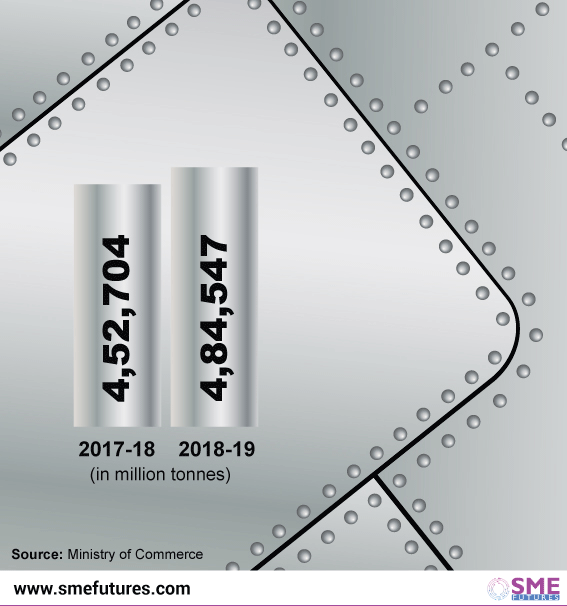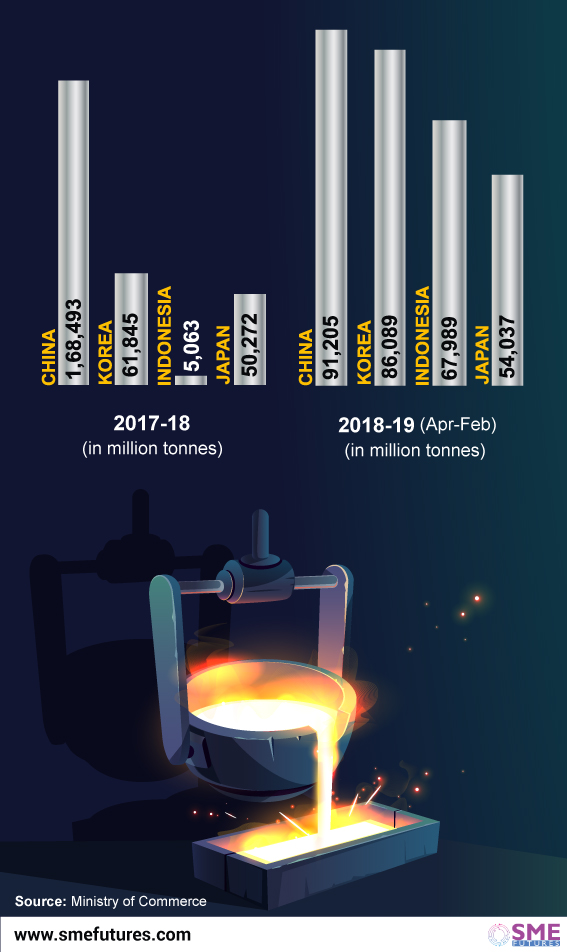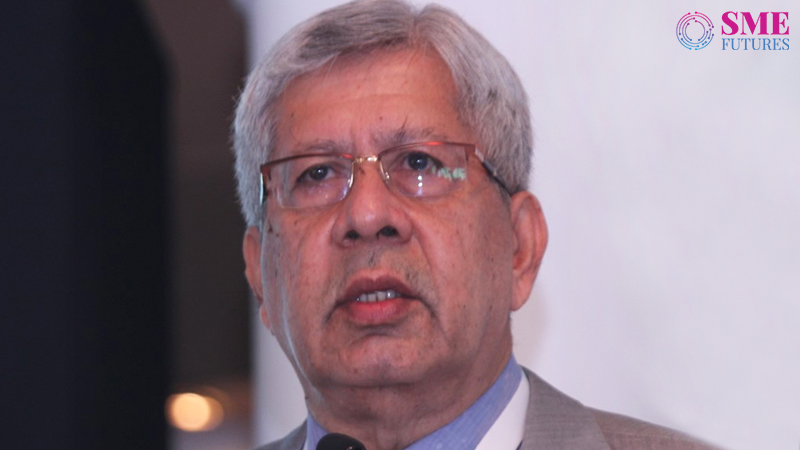India replaced Japan as the world’s second largest steel producing country last year, with crude steel production reaching 106.5 million tonnes (Mt), increasing by 4.9 per cent from 2017. Whereas, Japan produced 104.3 million tonnes (Mt), down by 0.3 per cent compared to 2017 – according to the latest report by The World Steel Association, an international trade body for iron and steel industry.
While India is the second largest producer of stainless steel after China, it produced 3.74 Mt last year, which was up by 7 per cent from 2017, according to International Stainless Steel Association (ISSF). Growth in the sector can be attributed to the rising demand from other sectors such as, roads networks, infrastructure, real estate and automotive.
However, the domestic industry has also suffered material injury due to subsidization of the products. There have been allegations about dumping of flat rolled stainless steel from 15 countries including China, US, Vietnam and Japan. Following these complaints from Stainless Steel Pipe and Tubes Manufacturer Association; South India Stainless Steel Pipe and Tubes Manufacturer Association; and Haryana Stainless Steel Pipe and Tube Manufacturer Association, the Directorate General of Trade Remedies (DGTR) conducted a probe.
The directorate concluded that for five years, the government may impose countervailing duty on certain kinds of steel pipes and tubes exported from China and Vietnam. The recommended duty is in the range of 29.88 per cent and 10.33 per cent. This is to guard domestic players from cheap imports, however DGTR recommends duty, finance ministry takes the final call to impose it.
Here’s what KK Pahuja, President of Indian Stainless Steel Development Association (ISSDA), shares about the industry scenario, in a conversation with smefutures.com. He talks about DGTR probe, counterfeit problem and other issues related to the stainless steel sector.
Please throw some light on the current scenario in the stainless steel sector in India?
Indian stainless steel market, being the fastest growing in the world, is currently a global hotspot. According to the latest report from International Stainless Steel Forum (ISSF), the Indian stainless steel melt production last year was 3.74 MT, up by 7 per cent than 2017. Amidst a growing protectionist trade sentiment across the globe, India continues to be the world’s second largest stainless steel producer and consumer after China. Stainless steel demand has been growing to the tune of over 7 per cent CAGR in India for the last three decades, in contrast to a global stainless steel CAGR of about 5 per cent. Notably, the stainless steel demand growth rate in India is directly proportional (around 1.5 times) to the country’s GDP growth. Moreover, International Monetary Fund (IMF) has predicted that India will grow at ~7.5 per cent GDP in 2019-20. With this momentum, stainless steel consumption in India is expected to reach nearly 5.6 Mt by 2023.
The per capita consumption of stainless steel in India is ~2 kg, compared to the world average of ~6 kg, reflecting the potential for more consumption in India. Major players in India currently include the likes of Jindal Stainless, SAIL-Salem, Viraj Profiles Ltd and so on.
Recently, Directorate General of Trade Remedies (DGTR) carried out a probe into alleged dumping of stainless steel goods from other countries. What is going on and what is the way forward?
Countries across the world have introduced safeguard measures to protect their respective turfs. Be it United States’ section 232 or protectionist measures put up by the European Union, an international sentiment of safeguarding has made India a soft target for the dumping of stainless steel products.
Additionally, the existing Countervailing Duty (CVD) and Anti-Dumping Duty (ADD) on imports have also been ineffective, with imports being on a consistent rise (refer Illustration 1.1).
Illustration 1.1

Moreover, the existing ADD and CVD have led to a trade diversion via Free Trade Agreement (FTA) countries. This is clear from the table below, where imports from China reduced, while Indonesia registered a significant leap in imports. Source: Ministry of Commerce
Illustration 1.2

Consequently, the domestic stainless steel industry is witnessing under priced imports and is operating at a mere 60-70 per cent of its total installed capacity. Also, an import duty of 2.5 per cent on key raw materials like Ferro-Nickel and stainless steel scrap, further pushes the input cost for domestic players, thereby distorting the model of a level-playing field with global players.
This led the domestic stainless steel industry to file a petition that further invited a government investigation. The industry now expects a prompt action by the authorities. Strengthening existing and imposing further protectionist measures like ADD, abolishing the import duty on key raw materials, along with increasing the import duty on stainless steel finished products at 12.5 per cent, government can more such measures to provide a level playing field to domestic players, reducing India’s trade deficit.
Irrelevant of any industry, counterfeit products can be hostile. How big is the issue in the stainless steel market in India? What is being done?
Indian stainless steel producers are equipped to produce world-class stainless steel. However, counterfeiting in this segment has led to compromised quality of some of the products available in the market. Consequently, customers end up with sub-standard goods, thereby impairing supplier’s brand perception along with impacting public health and safety. Recently, Jindal Stainless launched a co-branding initiative in the stainless steel pipe and tube segment, which in a way sets apart the genuine stainless steel products from the mushrooming counterfeit ones. In this context, the Quality Control Order for stainless steel products notified by the Ministry of Steel will also act as a gatekeeper.
What according to you are some of the initiatives to maintain industry growth in times of a slowdown?
Stainless steel is increasingly being identified as a suitable metal for diversified applications in Automobiles, Railways and Transport (ART), Architecture, Buildings, and Construction (ABC), process industry, pipes and tubes, and hollowware or white goods segments. This is why, in case of market slowdowns in any particular segment, the demand cycles of other segments are nearly unaffected.
For instance, the recent slowdown in automobile industry has affected the production and operation processes at large, however stainless steel demand is picking pace across other segments such as hollowware, ABC, and railway infrastructure (like road-over- bridges, foot-over-bridges, benches, station redevelopment, etc.)
The domestic industry is also keen on expanding avenues for stainless steel. Domestic players, along with ISSDA, have recently identified several key focus areas for stainless steel usage to expand. These include electric rickshaws, bread moulds, fish cages and more.
Budget 2019 raised custom duty from 5 per cent to 7.5 per cent on stainless steel items. How is the market responding? How will it impact in the longer run?
Basic Customs Duty (BCD) on certain stainless steel products like ingots (HS code 7218, stainless steel semi-finished products) etc., has been raised to 7.5 per cent from 5 per cent. This barely changes the scenario, as there is hardly any import of these semi-finished stainless steel products in the country. Most of the import comprises stainless steel flat products, grabbing a market share as high as 20 per cent. As a result, the country is currently a soft spot for dumping, burdening the domestic market with a slowdown in trade.
The producers had higher expectations of being safeguarded from imports of stainless steel finished products, in form of an increased BCD from 7.5 per cent to 12.5 per cent, at par with carbon steel. Much like the protectionist measures taken up by other countries, this would have stimulated production growth in the country.
Government’s announcement to focus on infrastructure projects brings out opportunities for the industry. What is your take on this?
Stainless steel is the new-age solution for sustainable infrastructure. The Architecture, Buildings, and Construction (ABC) segment constitutes ~20 per cent of the total Indian stainless steel demand. Furthermore, the demand for stainless steel in India is currently growing at 8-9 per cent per annum. Stainless steel is a key raw material for modern-day infrastructure projects like redevelopment of railway stations, new highways, and metro projects.
Stainless steel rebars and plates are key components of modern-day foot-over-bridges (FOBs) and road-over-bridges (ROBs). Transit buildings such as airports and metro rapid mass transport systems have also been extensively using stainless steel in various areas such as bollards, column claddings, ticketing counters, escalators, lifts, handrails, canopies and so on. Apart from this, stainless steel is also a key ingredient for pipe and tube applications in railings, furniture, decorative items, facades, etc. That said, government’s continuous boost to infrastructure and a lofty investment of nearly ₹ 35,000 crore for capacity expansion and modernization by the domestic industry have uplifted the stainless steel demand prospects for infrastructural projects.











